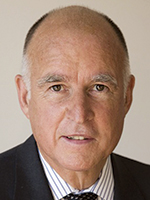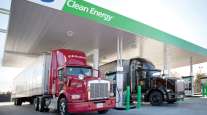Bloomberg News
Energy Revolution: California Approves $768 Million for Electric Vehicles

California’s electric utility companies will spend nearly $768 million on charging infrastructure for electric cars, trucks and buses, under a series of proposals approved May 31 by state regulators.
The programs, viewed together, are believed to be the largest state-level effort yet by the utility industry to encourage the adoption of electric vehicles. Gov. Jerry Brown has set a goal of having 5 million zero-emissions vehicles on California roads by 2030, a steep jump from the 369,300 pure electrics and plug-in hybrids now registered in the state.

Brown
The programs unanimously approved May 31 by the California Public Utilities Commission focus on creating the infrastructure to support charging stations particularly for electric trucks and buses, in contrast to previous expenditures, which have focused more on cars.
Transportation accounts for about 40% of California’s greenhouse gas emissions, and state officials see electrifying heavy-duty vehicles as a way to fight global warming and air pollution in one step, since regulators also expect much of the electricity to be generated by clean sources such as solar power. The programs approved May 31, funded by the utilities’ customers, place an emphasis on installing charging stations in disadvantaged communities or in facilities — such as ports — that tend to be located near low-income neighborhoods.
Electrifying California
California regulators have approved programs by utility companies to encourage electric vehicles and charging stations:
• $768 million on May 31 on charging infrastructure for electric trucks, buses and cars.
• $200 million in 2016 for chargers at workplaces and larger, multifamily dwellings.
• $43 million in January for 15 short-term pilot projects with electric school buses, and the installation of direct-current fast chargers and electrification of baggage vehicles at San Diego International Airport, among other things.
• $423 million in May from the Volkswagen diesel settlement for electric trucks, buses and port equipment. VW is committed to spending a total of $1.2 billion on clean transportation in California.
“Other states are watching, other utilities are watching, and I think this proposed decision moves us in the right direction,” Commissioner Carla Peterman said.
For the utilities, the programs also represent an investment in the future.
California’s utility companies have seen a growing number of customers install home solar arrays to generate their own electricity or join community choice programs, such as CleanPowerSF in San Francisco, to supply their power. The infrastructure needed to keep electric cars charged, in contrast, represents a rare growth opportunity.
“It’s potentially huge,” said Max Baumhefner, a senior attorney with the Natural Resources Defense Council’s clean vehicles project. “Electrifying the transportation sector could blow the ‘utility death spiral’ out of the water.”
Pacific Gas and Electric Co. will spend up to $22.4 million installing the infrastructure for more than 230 direct-current fast-charging stations, which can add 50 to 70 miles of range to a car’s battery in 20 minutes.
The utility also will spend $236.3 million on infrastructure and rebates to support electric trucks, buses and other medium or heavy-duty vehicles. Southern California Edison will spend up to $342.6 million on similar efforts. Together, the two utilities are expected to help install chargers at more than 1,570 sites, supporting 15,000 medium- or heavy-duty vehicles such as municipal and school buses.
San Diego Gas & Electric Co. will provide rebates for as many as 60,000 customers to install home charging stations and offer installation services, for a total of $136.9 million.
Together, the three utilities also will spend $29.5 million evaluating the effectiveness of all the programs.
California accounts for about half of all sales nationwide of electric or plug-in hybrid vehicles.
PG&E did not have an estimate May 31 for how much the commission’s decision would increase monthly bills for its customers. However, when the company proposed the programs approved May 31 — together with other electric vehicle projects that the commission already approved in a separate proceeding — PG&E estimated that a typical residential customer would pay 28 cents more per month.
California’s investor-owned utility companies make their profits largely off the value of the infrastructure — the poles, wires, transformers and substations — that they install and maintain, not the amount of electricity their customers use. In most of the programs approved May 31, the utilities will install and own the wires leading to electric vehicle charging stations, rather than owning the stations themselves.
“This is a huge area that really needs to be tackled, and we think because the utilities have a strong history in infrastructure projects, we fit in really well into this space,” PG&E spokeswoman Ari Vanrenen said.
The programs come in response to a 2016 California law —SB 350 — that directed the commission and the utilities to develop ways to electrify transportation across all sectors of the economy.
Last week, the California Air Resources Board voted to spend up to $423 million from the Volkswagen emissions-cheating settlement on incentives for electric school and municipal buses, zero-emission freight trucks and replacements for polluting port equipment. As part of the settlement, Volkswagen has agreed to spend $1.2 billion on clean transportation in California over the next decade.
Baumhefner of the Natural Resources Defense Council said the efforts of the air board and the commission will work together.
“There’s a complementary relationship here, with VW diesel money for zero-emission trucks and buses, and utility investments providing the plugs for those zero-emission trucks and buses,” Baumhefner said. “It stretches the state’s VW money twice as far.”
Although the May 31 vote was unanimous, commission President Michael Picker expressed a note of hesitation about San Diego Gas & Electric Co.’s incentive program for at-home charging stations. Self-driving cars, he said, could lead to fewer people owning vehicles. The need for home charging systems would drop as a result.
“As we start to see more and more autonomous vehicles, I’m uncertain how much we want to invest in residential charging,” Picker said. “I think it’s an experiment — an expensive experiment."
Distributed by Tribune Content Agency, LLC




